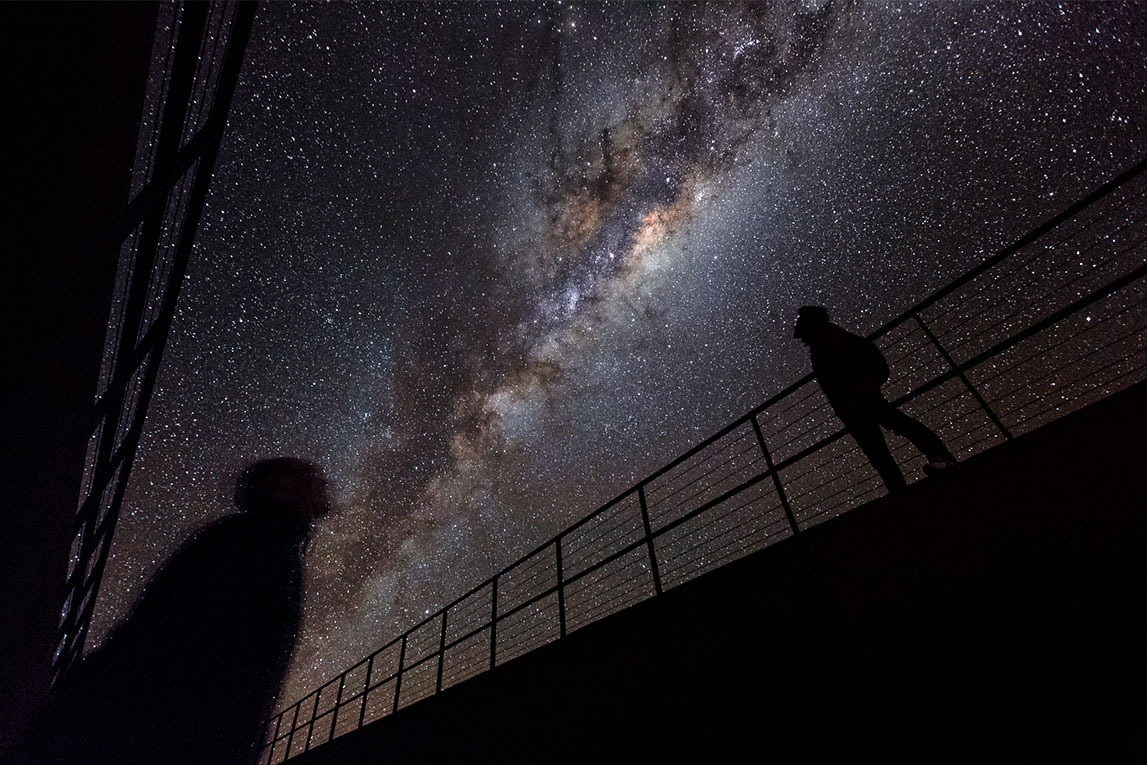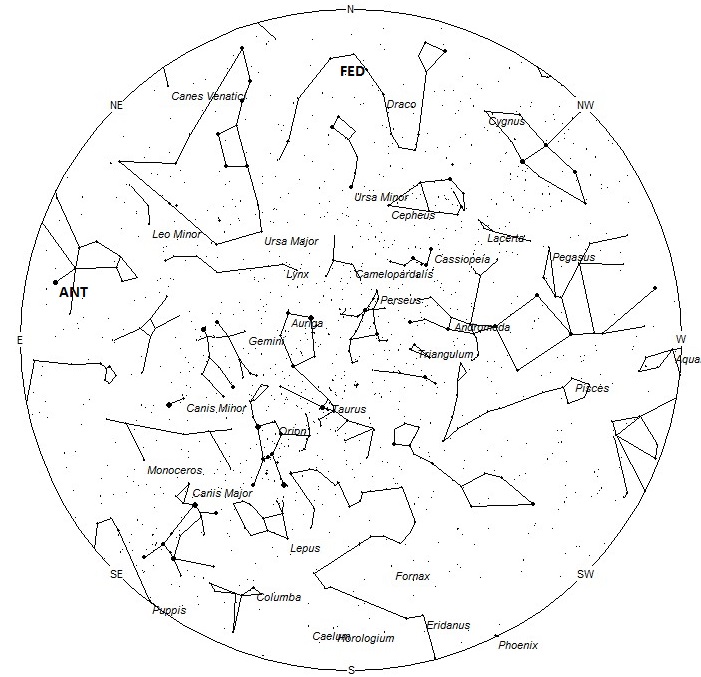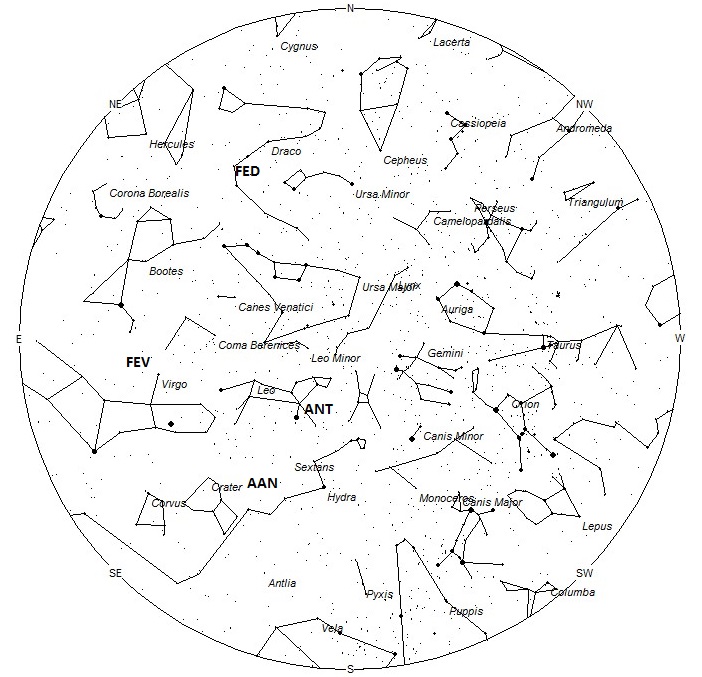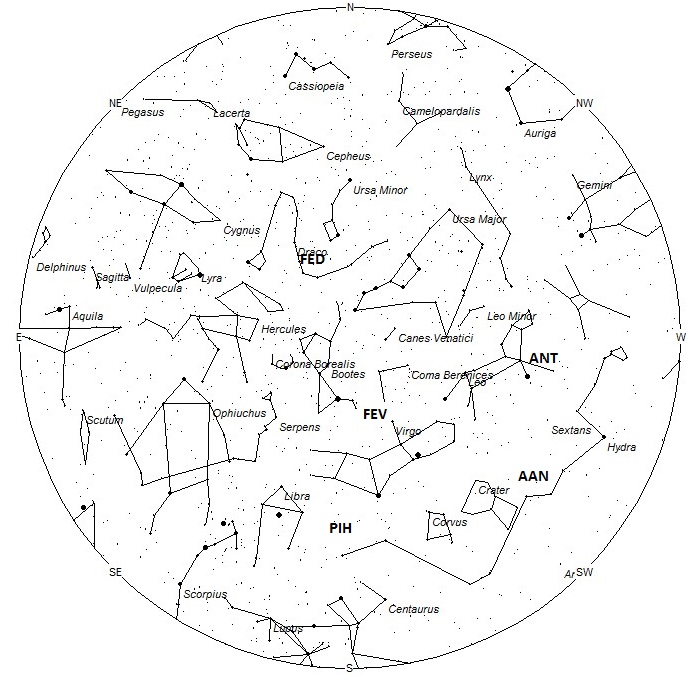
(ƒ/3.2, 16.0 mm, 20s, ISO3200 – Canon EOS 5D Mark III, F16-35mm f/2.8L II USM)
February offers the meteor observer in the northern hemisphere a couple of weak showers plus falling sporadic rates. This may not seem too exiting but you never know when surprises are in store. An errant earthgrazer from the Centaurid complex may shoot northward. Better yet, a bright fireball may light up the sky. February is the start of the fireball season, when an abundance of fireballs seem to occur. This lasts well into April and seems to occur mostly during the early evening hours. Rates are near maximum for those viewing from the Southern hemisphere. There are no strong showers this month but sporadic rates are well in excess of 10 per hour as seen from mid-southern latitudes.
During this period the moon will reach its last quarter phase on Wednesday February 7th. At that time the moon will lie 90 degrees west of the sun and rise near midnight for observers located at mid-northern latitudes. This weekend the waning gibbous moon will rise during the mid-evening hours making meteor viewing difficult the remainder of the night as the bright moon will obscure all but the brighter meteors. The estimated total hourly meteor rates for evening observers this week is 2 as seen from mid-northern latitudes (45N) and 4 from the southern tropics (25S). For morning observers the estimated total hourly rates should be near 7 as seen from mid-northern latitudes (45N) and 9 from the southern tropics (25S). The actual rates will also depend on factors such as personal light and motion perception, local weather conditions, alertness and experience in watching meteor activity. Morning rates are reduced during this period due to bright moonlight. Note that the hourly rates listed below are estimates as viewed from dark sky sites away from urban light sources. Observers viewing from urban areas will see less activity as only the brighter meteors will be visible from such locations.
The radiant (the area of the sky where meteors appear to shoot from) positions and rates listed below are exact for Saturday night/Sunday morning February 3/4. These positions do not change greatly day to day so the listed coordinates may be used during this entire period. Most star atlases (available at science stores and planetariums) will provide maps with grid lines of the celestial coordinates so that you may find out exactly where these positions are located in the sky. A planisphere or computer planetarium program is also useful in showing the sky at any time of night on any date of the year. Activity from each radiant is best seen when it is positioned highest in the sky, either due north or south along the meridian, depending on your latitude. It must be remembered that meteor activity is rarely seen at the radiant position. Rather they shoot outwards from the radiant so it is best to center your field of view so that the radiant lies near the edge and not the center. Viewing there will allow you to easily trace the path of each meteor back to the radiant (if it is a shower member) or in another direction if it is a sporadic. Meteor activity is not seen from radiants that are located far below the horizon. The positions below are listed in a west to east manner in order of right ascension (celestial longitude). The positions listed first are located further west therefore are accessible earlier in the night while those listed further down the list rise later in the night.
These sources of meteoric activity are expected to be active this week.
.
Details of each shower will continue next week when the moonlight conditions are more favorable.
| SHOWER | DATE OF MAXIMUM ACTIVITY | CELESTIAL POSITION | ENTRY VELOCITY | CULMINATION | HOURLY RATE | CLASS |
| RA (RA in Deg.) DEC | Km/Sec | Local Standard Time | North-South | |||
| Anthelion (ANT) | – | 09:52 (148) +13 | 30 | 01:00 | 2 – 1 | II |
| alpha Antliids (AAN) | Feb 01 | 10:40 (160) -11 | 45 | 02:00 | <1 – <1 | IV |
| February Epsilon Virginids (FEV) | Feb 03 | 13:24 (201) +11 | 64 | 04:00 | <1 – <1 | IV |
| alpha Centaurids (ACE) | Feb 08 | 13:44 (206) -57 | 59 | 04:00 | <1 – <1 | IV |
| pi Hydrids (PIH) | Feb 06 | 14:04 (211) -21 | 55 | 05:00 | <1 – <1 | IV |
| February eta Draconids (FED ) | Feb 04 | 16:00 (240) +62 | 35 | 07:00 | <1 – <1 | IV |
 American Meteor Society
American Meteor Society



I live in NJ and viewing here is not the best because of the light pollution. Even on darkest nights it’s touch and go. But I’ve seen some pretty cool and bright meteors right from my bedroom window during some of the bigger showers.
I think here in southern Indiana my son and I got a few of those fireballs on video and pictures. It was cool!
I live in Lockport, IL and witnessed a fireball streaking very quickly across the sky this am at approx 3 am. I have not heard any other news or comments on the internet about this
Pat and All,
Looks like a lot of other folks saw your fireball too. Check out: https://www.amsmeteors.org/members/imo_view/event/2018/857
Robert Lunsford